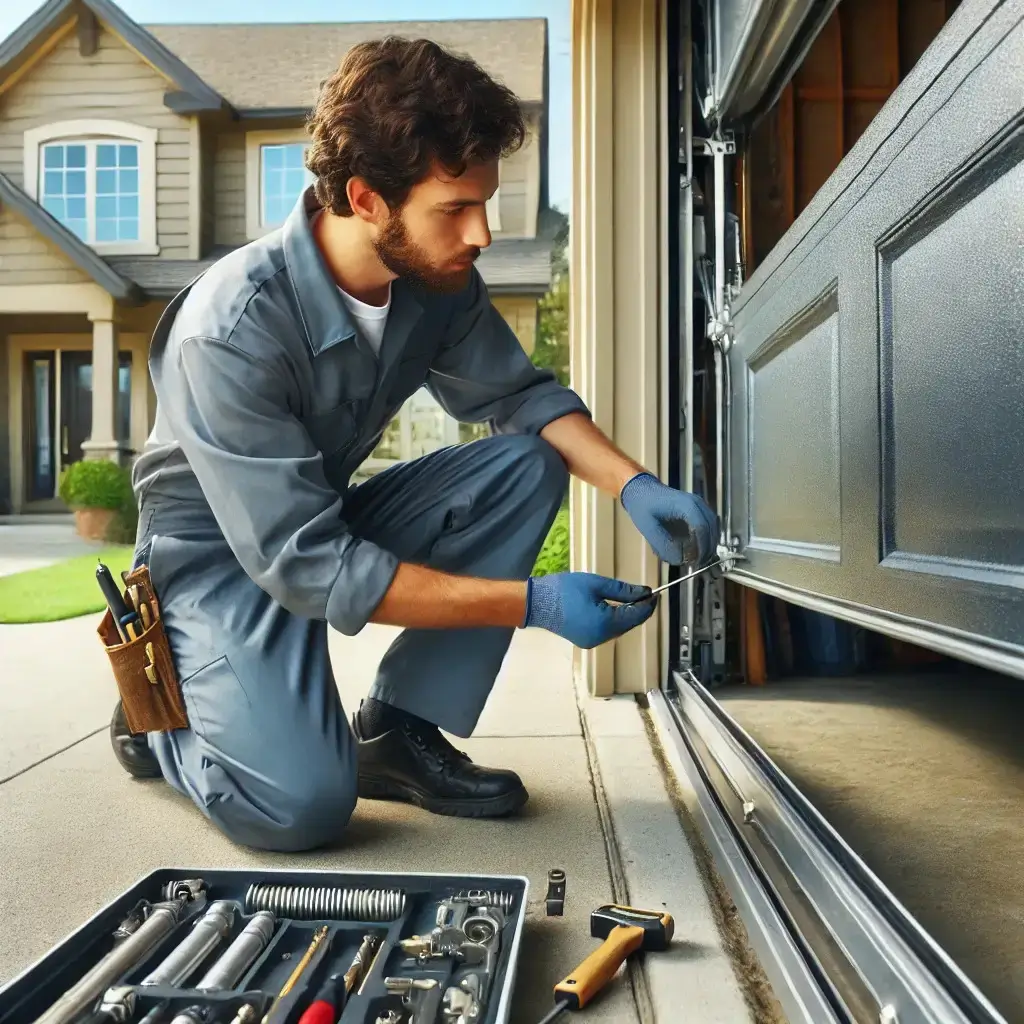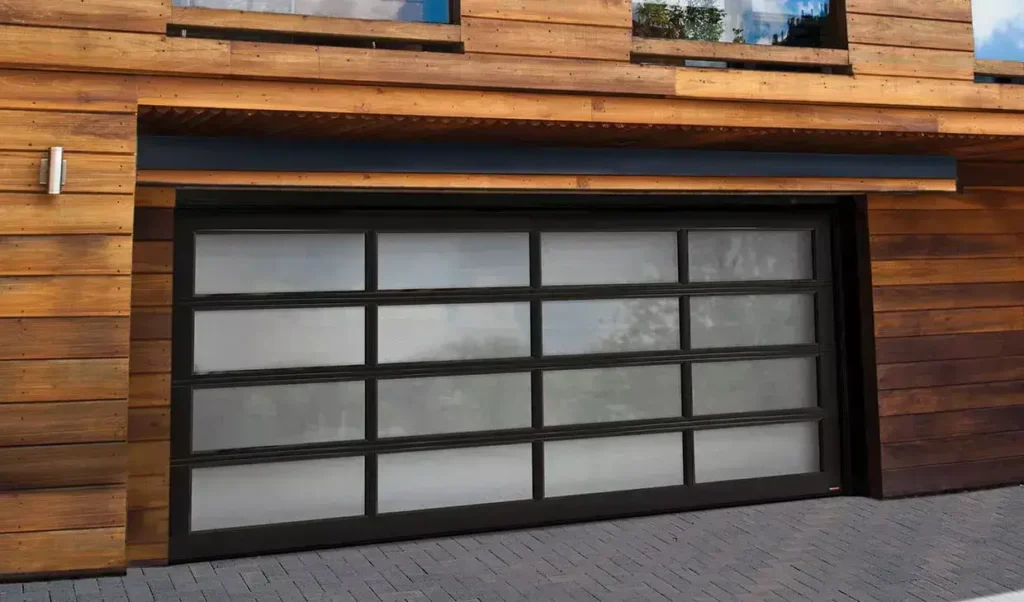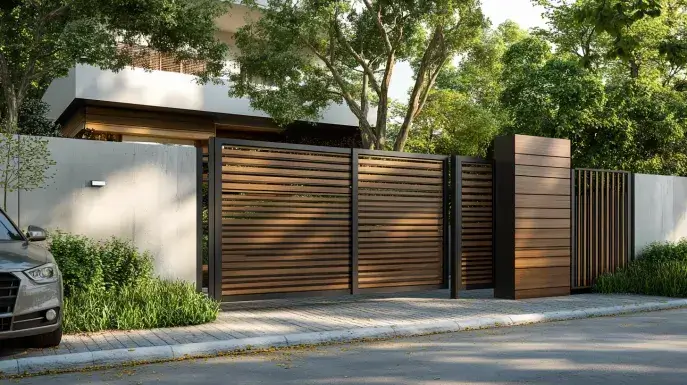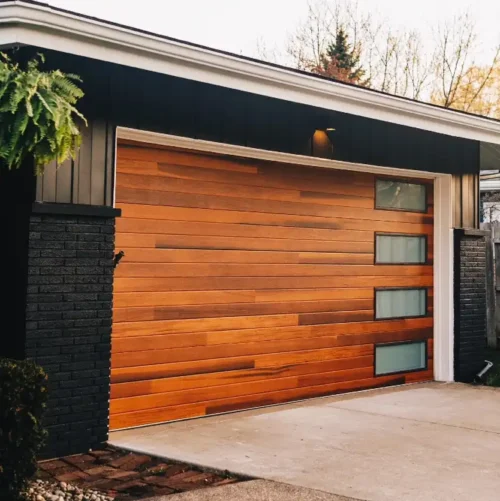Tip #1: Monthly Visual Inspections: What to Look For

Performing a monthly visual inspection of your garage door or gate is a simple yet crucial task that can save you time, money, and a whole lot of hassle down the road. It’s an easy way to catch small issues before they turn into bigger, more expensive problems. Plus, you don’t need to be a repair expert to do it – just a careful eye and a few minutes each month will do the trick. Below, we’ll guide you through the key areas to inspect and what you should look for to keep your garage doors and gates in tip-top shape.
1. Inspect the Springs and Cables for Wear and Tear
Let’s start with the springs and cables, which are vital to the smooth operation of your garage door. The springs, either torsion or extension, are responsible for bearing most of the door’s weight. Over time, they can wear out, corrode, or even snap. During your inspection, check if they look worn, rusted, or stretched out. If you notice any of these signs, it’s a good idea to call a professional to replace them. A broken spring is not just inconvenient – it can also be dangerous, so this is one issue you don’t want to ignore.
Similarly, take a close look at the cables. They work alongside the springs to lift and lower the door smoothly. If you see any fraying or visible wear on the cables, it’s a red flag. These cables are under high tension, so it’s essential to have them inspected by a technician if there’s any visible damage. Handling these parts on your own can be risky, but spotting the issues early during your monthly check will help prevent unexpected breakdowns.
2. Check for Unusual Noises and Smooth Operation
Does your garage door make an odd noise every time you open or close it? Strange creaks, squeaks, or grinding sounds are often a sign that something’s not quite right. During your monthly inspection, stand nearby and listen closely while the door operates. You’re listening for anything out of the ordinary – smooth operation is key. If your door is making more noise than usual, it might be time to lubricate the moving parts, like the rollers, hinges, and tracks.
A properly functioning door should move up and down smoothly without any jerking or hesitation. Watch it in action – is it moving evenly, or does it seem to tilt or struggle as it opens? If it’s wobbling or moving unevenly, the tracks could be misaligned, or the rollers might need replacing. This kind of inspection is quick and easy, but it can make a big difference in catching problems early.
3. Examine the Weather Stripping and Seals
Weather stripping might seem like a small detail, but it plays a big role in keeping your garage protected from the elements. Take a look at the seals along the bottom and sides of your garage door. Over time, weather stripping can crack, become brittle, or even peel off completely. If you notice gaps or damage, it’s time to replace it. These seals help keep out moisture, dust, and pests, as well as improve the insulation of your garage.
For gates, check the seals around the moving parts where weatherproofing may be applied. Regular wear and exposure to outdoor elements can wear down these seals, making them less effective. Not only does replacing worn weather stripping prevent drafts and water damage, but it can also save you money on energy costs by keeping your garage temperature regulated.
4. Look for Damage to Panels and Hinges
Your garage door panels and hinges do more than just look nice – they provide structural integrity to the door. Each month, take a close look at the panels for dents, cracks, or warping, especially if you’ve had some rough weather recently. Damaged panels can affect how your door functions and could potentially lead to more serious issues if left unchecked.
The hinges connecting the panels should also be inspected for wear and tear. If they’re loose, rusted, or bent, they can affect how your garage door moves and increase the risk of mechanical failure. Tightening loose hinges is a quick fix, but if they’re showing significant wear, it might be time for a replacement.
5. Examine the Tracks and Rollers
Lastly, don’t forget to inspect the tracks and rollers. These are responsible for guiding your door as it moves. If the tracks are dirty or obstructed, they can cause your garage door to get stuck or move unevenly. Check for debris, dirt, or rust buildup along the tracks and clean them as necessary.
For the rollers, check if they are worn out, chipped, or cracked. Rollers can wear out over time, especially if they’re plastic. Upgrading to steel or nylon rollers can extend the life of your garage door and make it run more quietly. Replacing worn-out rollers before they fail will prevent larger issues from developing and keep your door running smoothly for longer.
Tip #2: How to Test Your Garage Door Balance Safely

Testing your garage door balance may sound like a task for the pros, but it’s something you can do yourself with just a little bit of care. An unbalanced garage door can put stress on the opener and other components, leading to costly repairs or even dangerous malfunctions. Luckily, testing the balance is straightforward, and you don’t need any fancy tools to get the job done. In this post, we’ll guide you step-by-step through the process and help you understand why it’s so important.
1. Why Checking Your Garage Door Balance Matters
Before diving into the how, let’s talk about the why. A balanced garage door ensures smooth operation and minimizes strain on the mechanical components. When the door is balanced, it stays put when partially open, and the opener doesn’t have to work overtime to lift or lower it. If the door is unbalanced, it may close too quickly, slam shut, or become difficult to open manually. Over time, this imbalance can wear out the motor and springs, leading to more expensive repairs. The good news is that testing the balance only takes a few minutes and can prevent bigger headaches later.
An unbalanced door is also a safety hazard, especially if you have kids or pets running around. A door that slams shut unexpectedly can cause injuries or damage, so making sure it’s balanced is essential for your home’s overall safety. And who doesn’t want the peace of mind that comes from knowing your garage door is in good working order?
2. Manually Lift the Door to Test Balance
Now for the fun part – actually testing the balance! With the garage door opener disconnected, stand inside the garage and grab hold of the handle, or edge of the door, whichever is easiest. Lift the door to the halfway point (about waist height) and let go. Here’s what you’re looking for: a balanced door should stay in place without moving up or down. If it stays right where you left it, congratulations! Your door is perfectly balanced.
However, if the door starts to rise or fall on its own, that’s a sign of imbalance. If the door falls closed, it means the springs might not be providing enough tension to support the door’s weight. On the other hand, if it starts to rise, the springs may be pulling too hard. In either case, it’s best to have a technician take a closer look and adjust the tension.
Be sure to avoid forcing the door open or closed during the test, as this could damage the door or injure you. Remember, if the door feels too heavy to lift or seems difficult to handle, stop the test and contact a professional. Garage doors are heavy and powerful, so handling them carefully is always the best approach.
3. What to Do If Your Door Is Unbalanced
So, what happens if your door fails the balance test? Don’t panic! The good news is that balance issues are often easy to fix with the help of a trained technician. Adjusting the tension in the springs is a common fix, but this is definitely not a DIY task – those springs are under immense pressure and can be dangerous if handled improperly. A professional will have the right tools and know-how to make the necessary adjustments safely and efficiently.
In the meantime, if your door is still functioning but seems a bit off, try to limit its use until it’s been checked out. Continued use of an unbalanced garage door can strain the opener and potentially lead to motor failure, which would make for a much bigger and more expensive repair job. It’s always better to catch the problem early and resolve it before it escalates.
4. Regular Testing for Long-Term Performance
Testing your garage door’s balance isn’t a one-time task. Ideally, you should check it at least once every few months, especially if you notice the door behaving strangely or hear unusual sounds during operation. Regular balance checks, combined with routine maintenance like lubricating the moving parts and inspecting the springs and cables, will keep your door functioning smoothly for years to come.
By making garage door balance testing a regular part of your home maintenance routine, you’ll prevent unnecessary wear and tear on your system, save on costly repairs, and, most importantly, keep your home safe. Plus, it only takes a few minutes – and that’s time well spent for the peace of mind it offers.
Tip #3: Preventive Measures for Winterizing Your Garage Door

Winter can be harsh on your home, and your garage door is no exception. The colder months bring snow, ice, and freezing temperatures, which can cause significant wear and tear on your garage door’s moving parts. To avoid any mid-winter surprises, it’s a smart idea to take a few simple preventive measures to winterize your garage door. Don’t worry – you don’t need to be a handyman to do this! With just a bit of effort, you can keep your garage door working smoothly through even the coldest months.
1. Check the Garage Door Opener Battery
Winter weather can be tough on your garage door opener’s battery, especially if you live in an area where temperatures regularly drop below freezing. If your opener is battery-powered or has a backup battery, it’s smart to check its charge before winter really sets in. A weak battery can slow down the opening and closing of your garage door, or worse, leave you stuck in the cold.
Replace the battery if needed, and keep an extra on hand just in case. You’ll thank yourself later when you don’t have to deal with a dead battery on a freezing morning! It’s also worth checking that the remote control and keypad are working properly – you don’t want to be fumbling with a malfunctioning opener in the middle of a snowstorm.
2. Consider Insulating Your Garage Door
If you live in a particularly cold climate, you might want to go the extra mile and insulate your garage door. Insulating your door can help keep your garage warmer and prevent energy loss, especially if your garage is attached to your home. An insulated garage door also tends to be quieter and more durable than a standard one, giving you more comfort and peace of mind during the cold months.
There are DIY insulation kits available if you feel up to the task, or you can hire a professional to install insulation for you. Either way, adding insulation can make a noticeable difference in your garage’s comfort level and energy efficiency during the winter.
Tip #4: Lubrication: Why It’s Essential and How Often to Do It

If you want your garage door or gate to work smoothly without any annoying squeaks or sudden breakdowns, regular lubrication is a must. It’s one of those simple maintenance tasks that can make a huge difference in how long your door lasts and how well it functions. And the best part? You can easily do it yourself! Let’s explore why lubrication is so important and how often you should give your garage door and gate the TLC they deserve.
1. Why Lubrication Matters for Your Garage Door or Gate
Your garage door or gate has a lot of moving parts, from rollers and hinges to springs and tracks. Without lubrication, these parts can grind against each other, leading to wear and tear over time. That annoying creaking sound you hear when your garage door opens? It’s probably because the metal parts are crying out for some lubrication!
When you lubricate the moving parts of your garage door, you reduce friction and keep everything running smoothly. This not only extends the life of the components but also helps prevent costly repairs down the road. It’s like giving your door or gate a little boost to keep it running at its best. Plus, a well-lubricated door is quieter, which means no more waking up the whole neighborhood every time you pull into the driveway!
2. What Parts Need Lubrication?
So, what exactly should you be lubricating on your garage door or gate? It’s all about focusing on the moving parts that experience the most friction. Here’s a quick rundown of the key areas:
- Hinges: The hinges allow your garage door to bend as it moves. Without lubrication, they can become stiff and cause the door to struggle during operation. Apply a little lubricant to each hinge, focusing on where the parts connect.
- Rollers: Rollers help guide the door along the tracks. If they get stuck or clogged with debris, your door can start to jerk or even get stuck. A quick spray of lubricant on the rollers will keep them gliding smoothly.
- Springs: Garage door springs do most of the heavy lifting, so keeping them well-lubricated is crucial. You’ll want to spray lubricant on the torsion or extension springs to reduce the strain and help prevent snapping or breaking.
- Tracks: While you shouldn’t apply lubricant directly to the tracks, cleaning and lightly lubricating the inside of the tracks will prevent rust and ensure smooth movement for the rollers.
- Locks and Latches: These parts can become stiff over time, making it harder to lock or unlock your garage door. A small amount of lubricant will keep them working effortlessly.
By lubricating these areas, you’re giving your garage door or gate the care it needs to stay in top condition, while also avoiding common mechanical issues.
3. How Often Should You Lubricate Your Garage Door?
Now that you know which parts need attention, let’s talk about how often you should lubricate them. In general, it’s recommended to lubricate your garage door every six months. Doing it twice a year ensures that the moving parts are always in good shape and reduces the risk of any unexpected problems.
However, if you live in an area with extreme weather, like intense heat, cold, or humidity, you might need to lubricate more frequently. Hot weather can cause parts to expand and contract, while cold weather can stiffen metal, both of which can put more stress on your garage door’s components. If you hear any squeaking, grinding, or notice your door isn’t operating as smoothly, it’s a good sign that it’s time to add some lubricant, even if it hasn’t been a full six months.
You should also consider lubricating your garage door more often if you use it frequently. For example, if your garage doubles as your main entrance and you open and close it multiple times a day, those moving parts are going to need extra care.
4. The Right Way to Lubricate Your Garage Door
Lubricating your garage door or gate is easy, but there are a few tricks to make sure you’re doing it right. First, always use a lubricant specifically designed for garage doors. Silicone-based lubricants or lithium grease work best because they won’t attract dust and dirt like other oils might. Avoid using products like WD-40, as they can actually dry out the parts instead of lubricating them.
Here’s a step-by-step guide to make sure your garage door is well-lubricated:
- Clean the Parts: Before applying any lubricant, clean the parts you’re going to treat. Use a dry cloth to wipe away dust, debris, and old lubricant that might have built up.
- Apply the Lubricant: Spray a small amount of lubricant onto each moving part, making sure not to overdo it. A little goes a long way, and you don’t want excess lubricant dripping onto your floor.
- Move the Door: After lubricating, open and close the garage door a few times to help distribute the lubricant evenly across all the parts.
- Wipe Off Excess: If you notice any drips or excess lubricant, wipe it off with a cloth to avoid attracting dust or dirt.
By following these steps, you’ll ensure that your garage door runs like a well-oiled machine, literally! The whole process takes just a few minutes, but the benefits can last for months.
Conclusion: Keep Your Garage Door Running Smoothly with Regular Lubrication
Maintaining your garage door is essential for ensuring smooth operation, prolonging its lifespan, and avoiding costly repairs. Regular tasks like lubricating moving parts, inspecting for wear and tear, and checking the door’s balance can prevent breakdowns and enhance safety. Simple upkeep, such as cleaning tracks and replacing weather stripping, keeps your door functioning efficiently, especially during extreme weather. By investing a little time in maintenance, you’ll enjoy a quieter, more reliable garage door while minimizing potential issues down the road.








